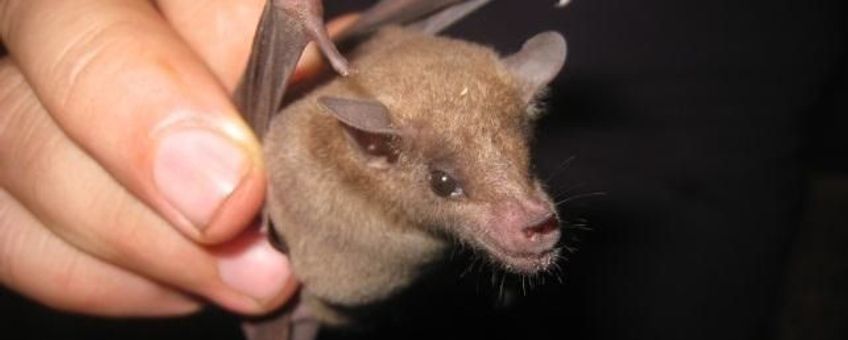
Vleermuizen steken zee over tussen Bonaire en Curaçao
Bericht uitgegeven [land] op [publicatiedatum]
Vorige maand ontdekten vleermuisonderzoekers uit het Caraïbisch gebied dat langsnuitvleermuizen (Leptonycteris curasoae) van Bonaire naar Curaçao vliegen, een afstand van zo’n vijftig kilometer. Tijdens vleermuisonderzoek in grotten op Curaçao werden drie vleermuizen aangetroffen die eerder op Bonaire werden geringd. De vondst betekent een doorbraak in het onderzoek naar de populatie dynamiek van deze voor de ABC-eilanden belangrijke soort. Na jarenlang onderzoek op Bonaire, Curaçao en Aruba is nu bekend dat de vleermuizen de zee over kunnen steken op zoek naar (vermoedelijk) voedsel. De langsnuitvleermuizen zijn samen met de ‘Miller’s long-tongued bats’ (Glossophaga longirostris) de belangrijkste bestuivers van cactussen op de eilanden, die op hun beurt weer een belangrijke voedselbron voor veel lokale landdieren vormen. Vervolgonderzoek zal hopelijk uitwijzen in welke mate vleermuizen 'eilandhoppen', of er ook vleermuizen van Bonaire of Curaçao van en/of naar Aruba vliegen, en of er ook vluchten van en/of naar het Caribische kustgebied van Venezuela uitgevoerd worden.
Lees verder in het Engels...
It was on January 15th 2013, during a bat research session in one of the important bat caves on the eastern part of the island of Curaçao, that local bat researchers of ABC-islands’ Bat Protection Program or PPR-ABC (PAP: Programa pa Protehé Ratonnan di Anochi di islanan ABC) captured and released two individuals of the Curaçaoan Long-nosed bat (Leptonycteris curasoae), which were previously tagged on Bonaire.

This finding signifies a major breakthrough in understanding the population dynamics of this key species in northern South America, and especially in the case of the ABC-islands. After more than 4 years of continuous work on Bonaire and 1 year of work on Curaçao and Aruba, we got the first two animals that show a behavior that could be common for the species in this set of islands: they can switch islands for food by flying across the sea. The Curaçaoan long-nosed bats are together with the Miller’s long-tongued bats (Glossophaga longirostris), the main pollinators of all columnar cacti on the islands, which in turn are a major food source for the local terrestrial fauna. Later that week another tagged bat from Bonaire was caught in the most western major cave of the island (Kueba Bosa 3). Could these mammalian pollinators be travelling to Aruba too?!
Curaçao harbors a total of 9 species (including the two previously mentioned pollinator species) of bats that feed on nectar, insects, fruits and even fish.
The current bat research activities conducted on Curaçao, Aruba, Bonaire and northern Venezuela are part of a long-term Bat Research and Conservation Plan designed and conducted under the coordination of four institutions: Arikok National Park Foundation in Aruba, Carmabi Foundation in Curaçao, Stinapa Bonaire in Bonaire, and Insituto Venezolano de Investigaciones Científicas (IVIC) in Venezuela. A specific component of this plan is to acquire more knowledge on the population dynamics of the Curaçaoan long-nosed bat. Previous research conducted by Carmabi and international bat researcher Sophie Petit on the major bat caves of Curaçao in the previous decades showed heavy seasonal fluctuations in population sizes of mainly the Long-nosed bat. Sometimes normally densely populated caves were found totally empty. Until last Tuesday, it was only hypothesized that these bats might travel between the ABC-islands and the possibly the Paraguaná peninsula (northwestern Venezuela). The capture of the Bonairean bats confirmed that, at least, there is connection between the populations of this species inhabiting Bonaire and Curaçao.

The bats have been tagged by ringing them on their forearm with coded aluminum rings. The code constitutes the initials of the bat specialist supervising the project, Jafet M. Nassar, the initial letter of the island where the bat was marked, followed by a unique number that reflects the number of bats ringed on each island. Lepto JNB 0577 was ringed 2.5 years ago and Lepto JNB 2046 was ringed in November 2011 on Bonaire. Although this finding constitutes a major breakthrough for the study of bats on the ABC islands, many critical questions about the bat species inhabiting the islands still remain unanswered and continued research on all three islands and Venezuela is necessary to understand and protect these very important and threatened mammals in this part of the Caribbean
For more information and nice pictures visit PPR-ABC Curacao-team Facebook page: Bat Conservation Curacao.
Text: Clifford de Lannoy MSc, Carmabi foundation
Pictures: Jafet M. Nassar
Nederlandse introductie: Sara Mulder, De Natuurkalender
